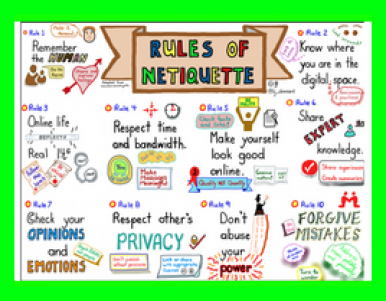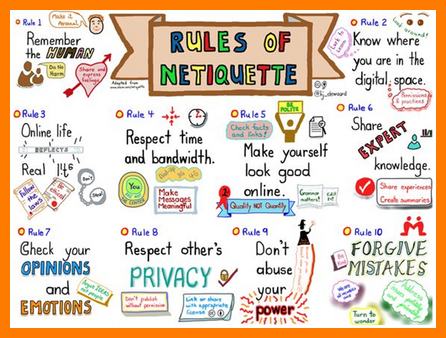
Hors d'oeuvres # 014
Respond to any email, almost, immediately. The Rule of the Thumb is within the next "four hours," if one can; if not, no later that 24 hours!
What is Email Netiquette ?
Email netiquette simply refers to etiquette in writing or responding to emails. As we all know, most of the world’s communication are through the use of technology.
Some communicate through phones while others communicate through their computers using chat services or email.

A more complete discusion about this issue can be found in the following excerpt:
What is Email Netiquette?
- Email netiquette simply refers to etiquette in writing or responding to emails. As we all know, most of the world’s communication are through the use of technology.
- Some communicate through phones while others communicate through their computers using chat services or email.
- Unknown to some, there are also basic guidelines and supposed rules in the electronic version of mail. Some of the formalities of the traditional mail may have been gone, but the rules on proper communication stayed with modern email communications.
- Much of email netiquette may be applied to the corporate world since many employees use emails everyday to go about their tasks. Most companies emphasize that there is a need to have some standard or guide in handling email in the offices.
- The most basic reasons for such rules include maintenance of image and professionalism, increase productivity and efficiency, and liability protection. To maintain professionalism, basic email rules apply. It is but common sense that some companies do not allow forwarding of unnecessary personal messages and pictures to colleagues at work.
- Some employees are also restricted in terms of email layout, while some are warned not to use company email addresses in personal communications.
- To increase efficiency and productivity, employees are usually advised to make emails short and to be concise in responses. This will eventually result to less reading time and easier understanding of the message.
- Some are also advised to check and answer emails promptly so as not to hamper the tasks of those involved. Others are also asked not to hit “Reply All” when replying to emails to avoid sending out messages to non-essential people in the email loop.
- And for liability protection, employees are advised to be very careful with their choice of words when communicating with clients, suppliers, and other business associates.
- Some companies also require the use of disclaimers on the bottom of the email to add further protection for the company.
- Rules on email netiquette are not exactly etched in stone.
- But one must practice common sense to ensure proper and courteous communications with other people. One must also note that one rule from a particular organization may not apply to another. So it’s still best to know what is allowed and what is not appropriate.
Retrieved from: What is Email Netiquette? - A Knowledge Archive (infomory.com)
What is Good Email Netiquette?
Proper Internet etiquette is often referred to as Netiquette. Students and teachers can avoid embarrassing situations by adhering to some simple guidelines for electronic communication.
The following is a list of standards for Netiquette:
- Always identify yourself and keep your messages brief and to the point. Remember that not everyone accesses email from a computer these days.
- Many people use portable devices such as cell phones to quickly check their email while they are away from a computer. They will appreciate not having to wait for the long messages to download.
- Include a concise subject line with all of your emails. This will allow the recipient to quickly scan their mailbox to see if the message is something they need to act on or “junk” email.
- Let your recipient know right away if any action is required of them. The easiest way to do this is by marking emails that do not require a reply or other action as FYI emails. This can be indicated in the subject line.
- Avoid “flaming” (inflammatory or antagonistic criticism) or sending insulting, abusive, or threatening remarks. There is no “unsend” option in email. Once a “flame war” starts, it tends to escalate quickly, often leading to hurt feelings and tension among those involved.
- A good rule to follow is to ask yourself “would I say this to the person’s face? If you wouldn’t feel comfortable saying it to their face then it’s probably not appropriate for email either.
- Avoid using all capital letters in a message. This is perceived as SHOUTING and may cause hard feelings.
- Remember that email is not necessarily private. Your messages can be forwarded to many people without your knowledge.
- Before sending a message, read it over, double check the recipient(s) and make sure it would not become an embarrassment if it were forwarded to others not on your recipient list.
- Do not spam others. Spam is the practice of sending unsolicited email messages in bulk or overloading someone’s mailbox or server with messages. Spamming may be as simple as forwarding chain letters.
- Forwarding these chain letters not only creates work for the people on the other end, who have to spend more time going through their messages to separate the good messages from spam, but it also generates unnecessary network traffic.
- Include a signature that has your phone number or if you are sending internal email, your extension. This will make it easier for your recipient to contact you if they need to speak to you in person.
- Avoid recalling messages. Take the time to really determine if a message is necessary or not before sending it in the first place. By the time you send out a recall for your messages they have already arrived in the recipients’ mailboxes and they have probably already been read.
- The recall notice will just be one more message that has to be deleted.
Retrieved from What is good email Netiquette? » E-Mail » Mac » Tech Ease (usf.edu)
NOTE: Interested in knowing more a about this undertaking?
Please, read the following manuscript:
